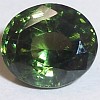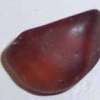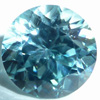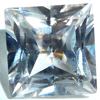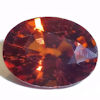
If you asked 100 random people the question “Is Zircon natural?” most would say “no”. That’s because most people confuse Zircon with Cubic Zirconia. It’s understandable to a degree. DeBeers has spent millions in advertising convincing people that CZ is worthless and unfortunately the average persons’ whole gem IQ is based on TV commercials. Let’s break down the confusion and learn a bit about both Zircon and the dreaded Cubic Zirconia.
Zircon is a natural gem and is very popular amongst gem connoisseurs because of its amazing optical properties. It has a very high refractive index and is highly doubly refractive meaning lots of sparkle. The natural material is most commonly a reddish brown similar to the color of Garnet. Green and light brown varieties are also predominantly natural color, but the reds, whites and blues are most likely the result of elaborate heat treatment techniques. Nearly all brownish Zircons are heat treated to get the very popular blue color. It is a complicated process of heating and cooling that’s best left for the professionals. Zircon is relatively brittle and there is usually a significant yield loss to fracturing even with the experts running the furnace. White and red are very desirable colors but you must pass right through the blue phase to get to white or red so most heat treaters just quit at blue and keep the profit up and the risk down. You will see whites in the market and these usually have slight blue or brown tint. These are most likely rejects from the blue process and not reallysincere attempts at white. Almost all the blue Zircons in the market are treated gems from Cambodian rough. Once you see and experience a really nice blue Zircon, it’s hard to appreciate the relatively dull look of Aquamarine or Topaz.
Cubic Zirconia is aptly named since it is a zirconium oxide that through manipulation is forced into cubic crystal growth. It may have a bad reputation but it a fantastic Diamond simulant and easily fools most people. Even experts must rely on testing equipment to separate them because their visual appearance is very similar. I think the worst part about a CZ is the fear that the owner will be fooled and embarrassed. The solution to that is to just buy CZ as a CZ for the usual next to nothing price and be happy.
As far as testing Zircon, CZ and Diamond to be sure of your purchase, it’s not easy. There are Diamond testers that are quite trustworthy at determining whether the gem is not a Diamond but do little to help you determine what else it is. The most common testing device, the refractometer, fails because all 3 of these (and many more Diamond alternatives) have refractive indexes beyond the capability of the equipment. But once you know that your gem has an RI above 1.8 (the usual refractometer limit), a specific gravity test will usually tell you what you need to know. Diamond has a specific gravity of 3.5 (lightest of the 3), Zircon is 4.7 while CZ is a whopping 5.8. Many times you can feel the difference between a Diamond and a CZ by just tossing it about in your hand.
